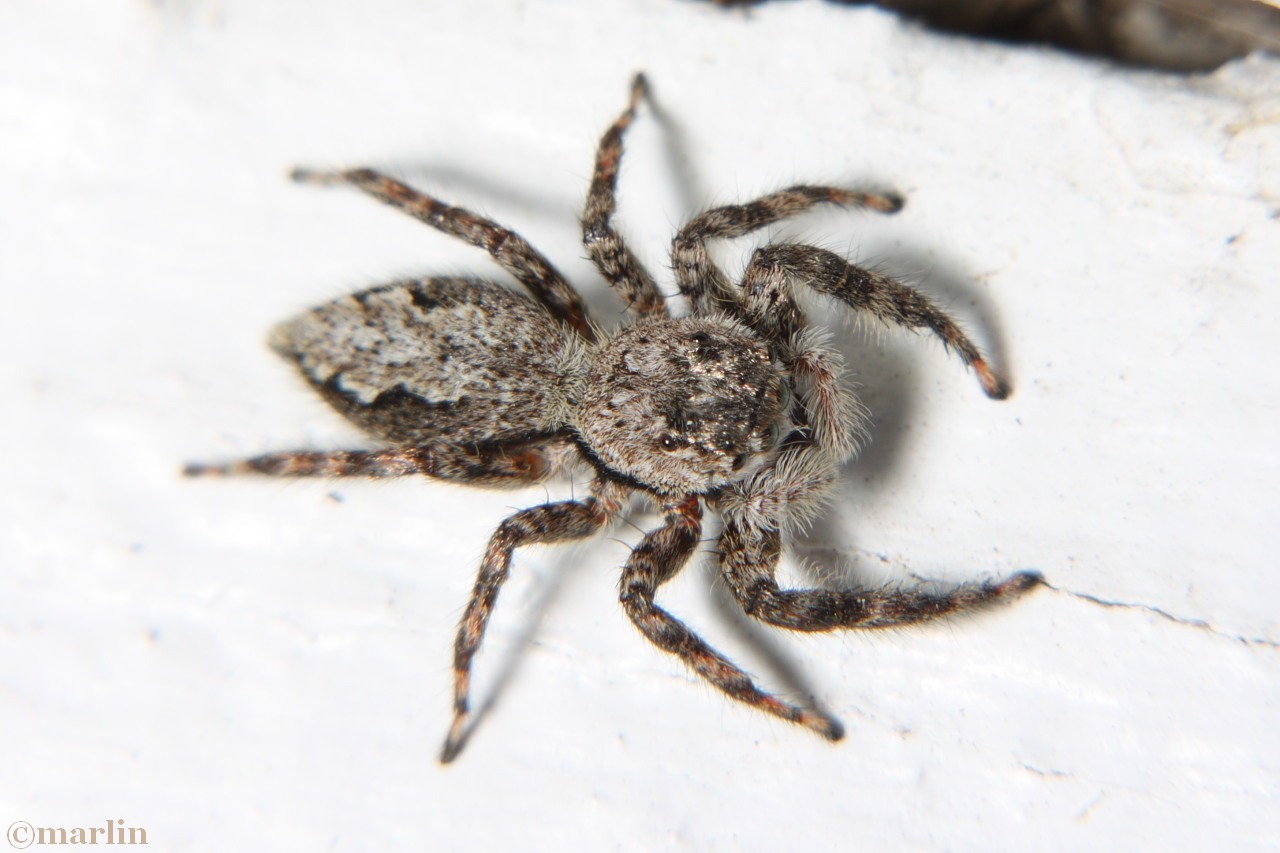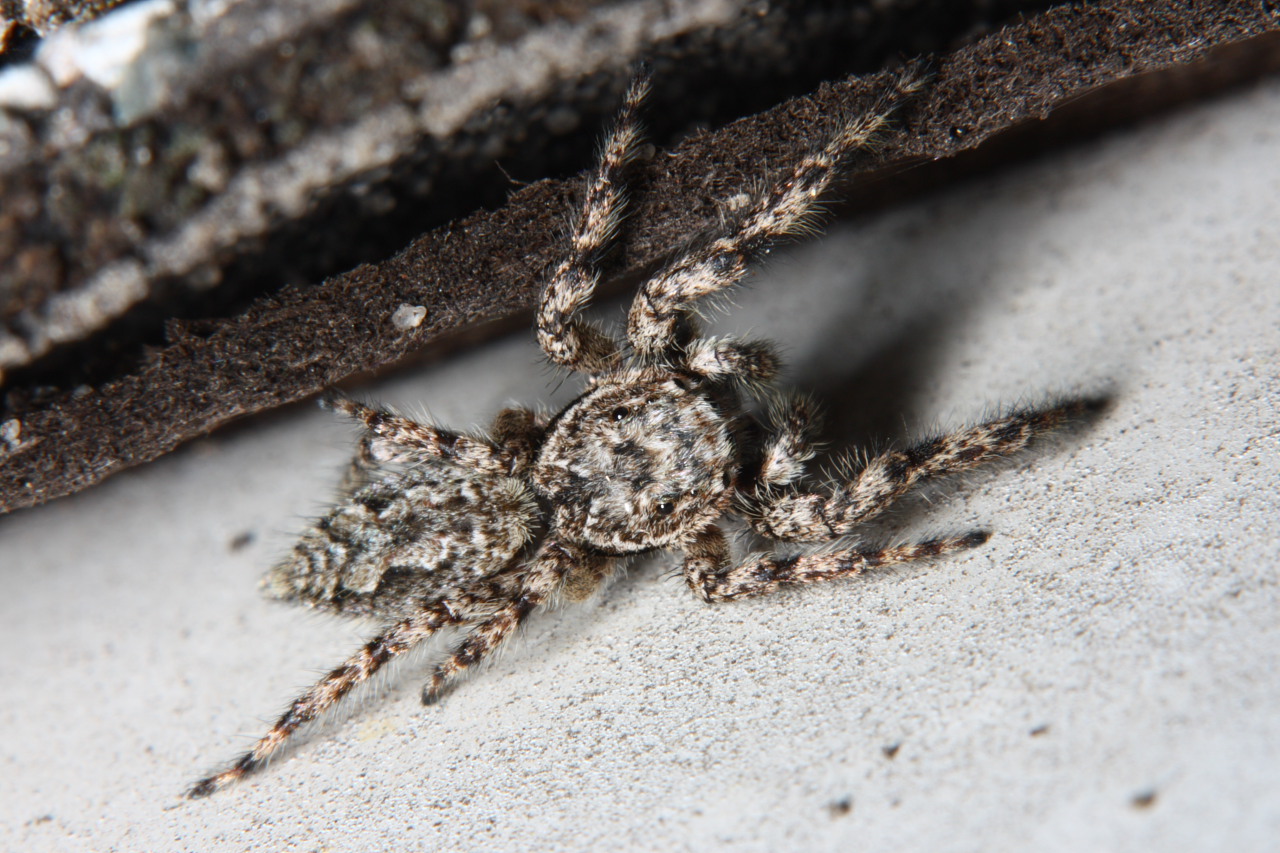Jumping Spider – Platycryptus undatus
These little jumping spiders hung around on my back porch all summer. They became very friendly and would frequently ignore me as they went about their business. I like having them around, sort of like tiny puppy dogs. I’m weird I guess.
Jumping spiders are small to medium in size, stout-bodied and short-legged, with a distinctive eye pattern. The body is rather hairy (pubescent) and frequently brightly colored or iridescent.
The jumping spiders forage for their prey in the daytime. They approach prey slowly and, when a short distance away, make a sudden leap onto the unfortunate animal. They are good jumpers and can leap at least 10 times their own body length.
I saw one jump off a tree stump to snatch an insect in mid-air and instantly swing back to the stump Tarzan-style via their lifeline, then hoist itself back to the starting position in a matter of seconds. I was surprised seeing it done the first time. I always thought they just dragged that single thread around so if they fell they could get back up – I wonder why I had never imagined they had an even better purpose for it?
Jumping spiders have excellent vision, among the highest acuity in invertebrates. The eight eyes are grouped four on the face (the two big anterior median eyes in the middle, and two smaller anterior lateral eyes to the side), and four on top of the carapace. The two large, forward-facing eyes (AME) are tubular behind the lens, with a well-developed musculature, unique to salticids, that supports and moves the retina – the opposite arrangement of our own eyes. [1]
Spider musculature is also different from ours: in the spider, muscles operate from the inside to move external skeletal elements; our own skeletal muscles surround the elements they operate. But even these glaring differences are nothing compared to the jumping spider’s brain and digestive system – their esophagus passes right through the brain, and one branch of the gut actually sits on top of the eyes and brain. [3]
Male jumping spiders have an unusual method of sexual intercourse: they use their palpi, the little “feelers” beside the face – in females, these palpi are simple and leg-like. Both males and females use them like little hands, to manipulate food and to clean their faces. But adult male palpi are larger and much more complex (that’s one way to tell a male spider: adult and sub adult males have the palpi swollen like boxing gloves).
When the male is ready to mate, he spins a small web and deposits a drop of sperm on it from the underside of his abdomen. He then places the tip of the palp into the sperm, and draws the sperm through the palp’s opening into the sperm duct, where it is stored. He then goes cruising for chicks. If he finds one, he performs a courtship dance for her, during which she assesses his fitness. If she accepts him, he places his palp against an opening on the underside of her abdomen (her epigynum), and guides it into place by putting a thumb-like projection, the tibial apophysis, into a groove in her epigynum. The palpus then expands, locks in place, and injects the sperm. [3]
 Male specimen sports an orange band under his eyes. He is somewhat smaller that the female. You can see the red tip of one fang peeping out just below his moustache. Jumping spiders are the only arachnids I can tolerate crawling on me. They seem so gentle and engaging! I have never been bitten.
Male specimen sports an orange band under his eyes. He is somewhat smaller that the female. You can see the red tip of one fang peeping out just below his moustache. Jumping spiders are the only arachnids I can tolerate crawling on me. They seem so gentle and engaging! I have never been bitten.
Jumping spider’s anatomical points of interest:
- Esophagus passes straight through the brain
- Portion of gut overlies the eyes and brain inside carapace
- Heart extends from abdomen into cephalothorax
- Leg muscles attached inside the carapace operate legs like marionette puppets
- Jumping spider’s brain volume to body size proportionate to human, but visual processing region is larger
- Salticids move retinas inside the eyes to look in different directions, as the lenses are fixed in the carapace
References
- Bugguide.net, Jumping Spider – Platycryptus undatus
- Jumping Spider Vision David Edwin Hill, licensed under the Creative Commons 3.0 Unported
- Maddison, Wayne. 1995. Salticidae. Jumping Spiders. Version 01 January 1995
Spiders Index | Spiders Main | Jumping Spiders | Orb Weavers | Nursery Web



![Jumping spider vision by David Hill [2] 495px-jumping_spider_vision_david_hill](http://cirrusimage.com/wp-content/uploads/2016/09/495px-Jumping_spider_vision_David_Hill.png)

